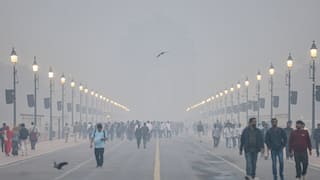Leonardo da Vinci's Forgotten Work On Gravity: Study Examines What He Got Right And Wrong
Leonardo da Vinci's experiments demonstrated that gravity is a form of acceleration. Also, da Vinci modelled the gravitational constant to around 97 per cent accuracy.

Leonardo da Vinci's understanding of gravity was centuries ahead of his time, according to a new study conducted by engineers from California Institute of Technology (Caltech). While da Vinci's understanding of gravity was not completely accurate, his experiments demonstrated that gravity is a form of acceleration. Also, da Vinci modelled the gravitational constant to around 97 per cent accuracy.
The study describing the findings was recently published in the journal Leonardo. As part of the study, the researchers drew upon a fresh look at one of da Vinci's notebooks. They found that da Vinci, a famed polymath, had devised experiments that explored gravity as a form of acceleration.
Leonardo da Vinci was well ahead of his time
Da Vinci lived from 1452 to 1519, and his primary hurdle was being limited by the tools at his disposal. For instance, da Vinci lacked a means of precisely measuring time as objects fell. However, da Vinci was well ahead of the curve in exploring concepts related to gravity. In 1604, Italian astronomer and physicist Galileo Galilei theorised that the distance covered by a falling object was proportional to the square of time elapsed. In the late 17th century, Sir Isaac Newton expanded on the theory to develop a law of universal gravitation. Newton described how objects are attracted to one another.
Engineers at Caltech studied da Vinci’s experiments in the Codex Arundel
Mory Gharib, the Hans W. Liepmann Professor of Aeronautics and Medical Engineering at Caltech, was the first person to spot da Vinci's experiments in the Codex Arundel. This is a collection of papers written by da Vinci, in which he covered science, art and personal topics. Gharib, in 2017, was exploring da Vinci's techniques of flow visualisation to discuss with students he was teaching in a graduate course. The art of making flow patterns visible is called flow visualisation.
What caught Gharib’s attention in the papers?
While exploring da Vinci's techniques of flow visualisation, Gharib noticed a series of sketches showing triangles generated by sand-like particles pouring out from a jar. He saw the sketches in the newly released Codex Arundel, which can be viewed online on the official website of the British Library.
In a statement released by Caltech, Gharib, the lead author on the Leonardo paper, said the phrase 'Equatione di Moti' on the hypotenuse of one of da Vinci's sketched triangles was what caught his attention. This made Gharib interested to know what da Vinci meant by that phrase.
An isosceles triangle is one in which two sides are equal, and the hypotenuse is the side of a triangle opposite to the right angle. This means, the sketched triangle Gharib referred to was a right-angled isosceles triangle.
Gharib worked with his colleagues Chris Roh and Flavio Noca to analyse the notes. According to Caltech, Noca provided translations of da Vinci's Italian notes, which were written in his famous left-handed mirror writing that reads from right to left. The trio carefully studied the manuscript's diagrams.
What was da Vinci’s experiment?
The study said that in the papers, da Vinci described an experiment in which a water pitcher would be moved along a straight path parallel to the ground. The pitcher dumped out either water or granular material, most likely sand, along the way. The notes of da Vinci made it clear that he was aware that the water or sand would not fall at a constant velocity, but would rather accelerate. The material was observed to stop accelerating horizontally. This is because the material was no longer influenced by the pitcher. The acceleration of the material was purely downward due to gravity.
The study said that when the pitcher was moved at a constant speed, the line created by falling material was vertical, so no triangle was formed. However, if the pitcher was accelerated at a constant rate, the line created by the collection of falling material made a straight but slanted line. Together, the lines formed a triangle.
Da Vinci pointed out in a key diagram that if the pitcher's motion was accelerated at the same rate that gravity accelerates the falling material, it creates an equilateral triangle. This is what Gharib originally noticed. He saw that da Vinci had highlighted with the note "Equiatione di Moti" or "equalization (equivalence) of motions."
According to the study, engineers at Caltech recreated the experiment depicted in da Vinci's journal. They showed that if the motion of a pitcher pouring out water or granular material is accelerated at the same rate that gravity accelerates the falling material, it creates an equilateral triangle. An equilateral triangle is one in which all the sides are equal in length.
What was da Vinci’s mistake?
The study said that da Vinci sought to mathematically describe that acceleration, but it is here that he did not quite hit the mark, according to the authors. The team used computer modelling to explore da Vinci's process, and run his water vase experiment.
Roh said the researchers noticed that Leonardo wrestled with the experiment, but he modelled the equation as the falling object's distance proportional to 2 to the t power, where 't' represents time, instead of writing the distance as being proportional to t squared.
Roh said this was wrong, but the researchers later found out that da Vinci used this sort of wrong equation in the correct way.
Da Vinci, in his notes, illustrated an object falling for up to four intervals of time. This was a period through which graphs of both types of equations lined up closely.
Gharib said the fact that da Vinci was grappling with the problem in this way, in the early 1500s, demonstrates just how far ahead his thinking was.







































